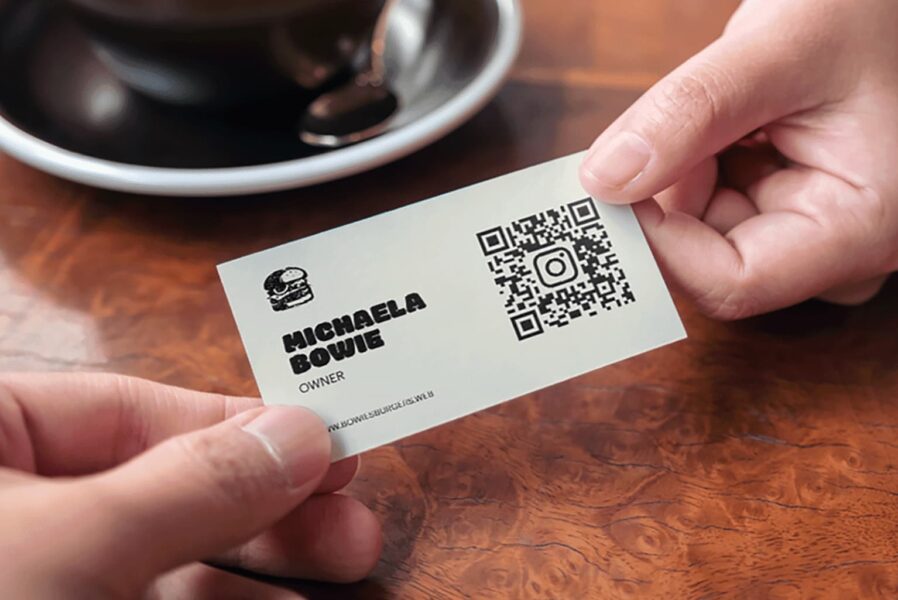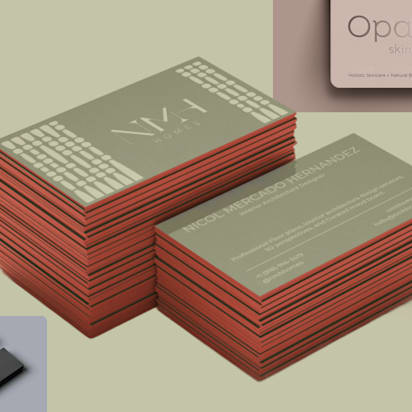Paper business cards still matter, but digital business cards meet people where they actually connect today: on phones, on LinkedIn and inside CRMs. They’re mobile-first, always up to date and far less likely to get lost at the bottom of a drawer.
Digital business card examples make it clear: With one tap or scan, you can share details instantly, update them anytime without reprinting and even track who engages with your card. It’s a smarter, faster way to network that saves money, cuts down on waste and helps your details stick.
- See real digital business card examples across industries like tech, real estate and design to inspire your own.
- Make your digital card stand out with features like one-tap contact saving and built-in booking links.
- Benefits for small business owners include lower costs, instant updates and trackable engagement.
- Practical digital business card ideas include adding a headshot, one main call-to-action and branded colors.

What are digital business cards?
A digital business card is a modern way to share your details instantly, without the need for stacks of paper. Instead of handing out a card that may get lost in a drawer, you use a QR code card, an NFC plastic or metal card, a wallet pass or even a short link that works anywhere online.
Here’s how they work in practice:
- Tap with NFC: Hold the card near a phone and your profile opens instantly. No apps, no downloads; just one tap to connect.
- Scan a QR code: Printed on your card, sign or badge, it links directly to your details. It’s perfect for events, store counters or even vehicle decals.
- Click a short link: Shareable via email, text or social media, this option works well for online networking and follow-ups.
Once shared, your contact information can be saved straight to a phone, synced to an address book, logged into a CRM or even added to an email signature. That means no more typing numbers into phones or losing touch with someone because a paper card went missing.
Want to dive deeper into how they work? Learn more about digital business cards.
From paper to pixel: How business cards evolved
For decades, business cards were straightforward. You designed them once, printed them in bulk and handed them out until your details changed. If your phone number or job title updated, it meant ordering another round and getting rid of old cards you’d never use.
Digital technology changed that pattern. Now you can update your card once and share it everywhere. Instead of carrying stacks of paper, you carry a single card or link that’s always current. It’s faster, lighter and more reliable than hoping someone keeps track of your printed card.
That doesn’t mean print is irrelevant. Many professionals still keep a few physical cards on hand for moments where tradition or formality matters. But leading with a tap-to-share or scan-to-connect card ensures your details land directly in someone’s phone, where they’re less likely to be lost.
This hybrid approach gives you the best of both worlds. Digital cards handle the heavy lifting of networking, while printed cards can still deliver a polished impression.
Still want the best of both worlds? Explore our business card printing options to pair with your digital card.

Digital business card examples by industry
Here’s how different industries are using digital business cards, with design tips and sharing strategies.
Technology and SaaS
At trade shows and conferences, SaaS teams need quick ways to capture interest before prospects move on. Digital business cards link directly to product demos or free trials, so follow-up feels effortless.
- Use case: Share product pages and demo sign-ups at events.
- Design tips: Product screenshot thumbnail, one clear CTA, short job title.
- Sharing idea: Preload a calendar link so prospects can book demos instantly.
- What to measure: Monitor demo bookings from card clicks.
Creative and design
Designers and creatives often win work by showing their style on the spot. A digital business card can double as a mini portfolio that clients can view instantly, even after leaving an event.
- Use case: Showcase portfolios on the spot.
- Design tips: Hero image, Behance or site link, clean typography.
- Sharing idea: Add a “View latest work” button that drives clicks.
- What to measure: Portfolio visits and click-throughs.
Real estate and property
Open houses and inspections move fast and paper sign-in sheets often get lost. With a digital card, agents can capture leads and appointment requests instantly while giving buyers easy access to their details.
- Use case: Collect appraisal requests during open homes.
- Design tips: Professional headshot, brokerage logo, “Book an appraisal” button.
- Sharing idea: Place QR codes on yard signs or listing sheets to widen reach.
- What to measure: Appraisal requests and contacts saved.
Healthcare and wellness
Healthcare providers, clinics and wellness businesses rely on simple booking flows. A digital card can store essential details, provide a map for directions and let patients schedule follow-ups instantly.
- Use case: Streamlined bookings and follow-ups.
- Design tips: Compliance-friendly info, booking link, location map.
- Sharing idea: Reception staff can scan the card to save practice details.
- What to measure: “Book now” clicks for appointments.

Hospitality and travel
Restaurants, hotels and tour operators thrive on repeat visits and easy reservations. Digital cards allow them to share menus, hours and booking links that update in real time, cutting out outdated print materials.
- Use case: Share menus, reservations and tour information.
- Design tips: Hero photo, operating hours, “Reserve a table” or “Book a tour” button.
- Sharing idea: Add QR codes to table tents, menus or tour badges.
- What to measure: Reservation clicks and booking confirmations.
Trades and home services
Plumbers, electricians and contractors build trust with fast quotes and easy reviews. A digital card makes it simple for clients to request a quote on-site or leave a review after the job is done.
- Use case: Share quotes and review links on the spot.
- Design tips: License number, service list, “Request a quote” button.
- Sharing idea: Place a QR code sticker on your toolkit, invoice or vehicle.
- What to measure: Quote requests and review link clicks.
Events and entertainment
Performers, speakers and entertainers need a quick way to share their work. A digital business card can link to highlight reels, rider info and booking forms, making it easy for organisers and fans to connect.
- Use case: Share booking details, rider info or highlight reels.
- Design tips: Short video link, booking email, social media profiles.
- Sharing idea: Tap-to-share at meet-and-greets or backstage.
- What to measure: Booking form starts and inquiries.
Pick one clear action per card and make it the focus. That way, people know exactly how to connect with you.

Benefits of digital business cards for small business owners
Digital business cards bring practical benefits that go well beyond convenience. They’re designed to save you time, money and hassle, while giving you tools that traditional cards can’t match.
- Eco-friendly and cost-effective: No more boxes of outdated cards gathering dust. One quick update replaces costly reprints, which means less waste and lower long-term spend.
- Easy to share and update: Change your phone number, job title or headshot instantly, without waiting for a new print run. That flexibility helps you keep networking momentum even as your business grows.
- Customizable and on-brand: Use your brand colors, logo and preferred contact methods so every interaction feels consistent and professional. You can even set a custom URL that makes your card easy to remember.
- More measurable: Unlike paper cards, digital cards show you how people engage. Track taps, scans and clicks to your website or booking page so you know what’s working and where to improve.
Tip: Treat your digital business card as both a calling card and a marketing tool. Keep it updated, check your analytics regularly and use those insights to make smarter business decisions.
The features that separate great digital cards from average ones
Not all digital business cards are created equal. The best ones make it simple to connect and easy for people to take action.
- Integrated contact info: One-tap to call, email or text, plus an easy save-to-contacts option.
- Lead capture: Add a form, calendar link or “Book now” button to turn interest into bookings.
- Branding: Use consistent colors, logos, headshots, job titles and even pronouns to reflect your brand identity.
- Rich media: Link to your portfolio, short bio, social profiles or a map to your location.
- tracking: Use analytics to see taps, scans and top-performing links.
- Team controls: For growing businesses, shared templates and role-based access keep everyone on-brand.
Focus on one clear action you want people to take and make that the star of your card.

How to create a digital business card that people actually use
Here’s a simple process to build a card that works.
- Choose your format: NFC card, QR code card, wallet pass or a mix.
- Pick your platform: Use one that updates in one place and tracks engagement.
- Design your card: Clear headshot, role, short value line, one main action.
- Add interactivity: Calendar links, portfolios, booking options or lead forms.
- Set up analytics: Decide what counts as a “win” before you share.
- Test on phones: Check iOS and Android, bright light and low light for QR scans.
What’s next: Personalization and smart features
The future of digital business cards is about tailoring every connection so it feels personal and relevant. Instead of sharing the same static details with everyone, new tools make it possible to adapt your card to the moment.
- Smart routing: Share different links with new versus returning contacts, so first-time connections see your intro while loyal clients get direct access to booking or support.
- Auto-fill CRM: Send contact details straight into your pipeline, saving you from manual data entry and helping you follow up faster.
- Dynamic content: Swap hero images, offers or calls-to-action to match an event, season or campaign.
- Personalized intros: Add a short, pre-written blurb you can paste into DMs or follow-up emails for a warm, consistent introduction.
Treat your digital card like a personal microsite. Keep it updated, adapt it to different contexts and make sure the next step for your audience is always clear.
Create your own NFC digital card
Digital business cards are faster to share, easier to update and better at turning a hello into a next step. Start simple, make the main action obvious and track what happens.




